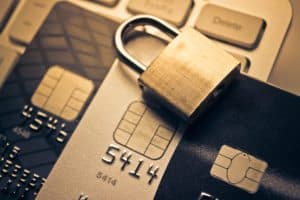What is credit card tokenization and what does it mean for your small business? Keep on reading to find out more.
Digital transactions are vital to the modern global economy.
However, concerns about online fraud and the need for increased privacy and security measures to protect sensitive cardholder data have created a requirement for improved methods to protect these transactions. To better secure their customers’ financial information and protect their businesses from data breaches, merchants should implement systems such as tokenization.
In this article, we’ll discuss what tokenization is, how it can benefit your business (and save you money!), and how it works. We’ll also show you how using tokenization makes PCI compliance easier and offer some tips for implementing tokenization in your business.
What Is Credit Card Tokenization?
Credit card tokenization involves the use of automated systems that replace credit card information with random letters and numbers. Instead of storing a customer’s unique credit card number, merchants can use tokenization to store a “token” that is worthless to both criminals and customers outside of a merchant’s system.
The same EMV technology that helps credit cards generate one-time codes for use for in-store purchases also makes tokenization possible. Credit card tokenization, though, also allows for card data protection both online as well as in-person.
Credit Card Tokenization VS Encryption
Credit card tokenization and credit card encryption are similar in that they both hide sensitive data from would-be interceptors. Both technologies are security measures designed to detect and prevent credit card fraud. Although they’re standard features of modern payment gateways, they use completely different technical processes to protect customer data during online transactions.
Merchants can use credit card tokenization to replace a customer’s actual card data with a token: a completely randomized alphanumeric character string. With tokenization, merchants can safely obtain a token and pass it back to a “table” that holds actual credit card data without ever exposing a customer’s real payment card information. Encryption, on the other hand, encodes a customer’s credit card data together with a “key” that can decode it. Merchants can use credit card encryption to protect card information with an algorithm and transmit it over a network where it must be decrypted using the key.
We strongly encourage businesses to implement both tokenization and encryption to safeguard their customer transactions. Credit card tokenization makes the most sense for businesses that need to process offline and online recurring transactions and card-on-file payments, especially if they operate out of many locations or through an eCommerce store. Encryption is best used for in-person, card-ready transactions that can cipher a customer’s card number as soon as they swipe it through an encryption-compatible machine.
Credit Card Tokenization VS EMV
EMV (EuroPay, Mastercard, and Visa) technology differs from tokenization in that it directly relates to a customer’s physical credit card. EMV, like tokenization, protects customer data by “hiding” it during a transaction. And like encryption, EMV stores sensitive payment information right on its microprocessor chip, which encrypts the digital signature that’s used during a transaction.
Unlike tokenization, EMV is exclusive to in-person transactions and requires both an EMV-enabled card and an EMV-compatible terminal to read the EMV chip embedded in the card.
So-called “chip-and-PIN” transactions require that customers “dip” — not swipe — their cards into an EMV terminal to process their payment. In recent years, banks have begun issuing credit and debit cards with NFC (near-field communication) technology that allows contactless payments made by simply tapping the card close to an NFC-capable card reader or terminal.
This is the same technology that powers Apple Pay (and similar services, such as Google Pay), allowing customers to make payments using their smartphones or watches.
Benefits Of Credit Card Tokenization
For card-issuing banks, enhanced payment security and a decreased risk of fraud are the primary benefits of tokenization.
Card-not-present fraud continues to be a growing problem, with overall losses of more than $32 billion in 2021 alone (almost $12 billion occurred in the US). Nonetheless, merchants have been slow to adopt this new technology which would help protect their businesses and lower overall losses due to fraud.
In 2022, the major credit card associations modified their interchange fee schedules to differentiate between tokenized and non-tokenized payments. As a result, non-tokenized card-not-present transactions are now significantly more expensive to process than they were in previous years. Conversely, interchange fees for tokenized card-not-present payments are now slightly less expensive than before.
If your credit card processor uses an interchange-plus or membership pricing plan, these savings will be passed onto you.
The bottom line is that using tokenization will save you money on your credit card processing costs, particularly if you process many card-not-present transactions.
With almost all credit card processors now offering tokenization at no additional cost, there’s simply no reason not to use it.
Other benefits of credit card tokenization include the following:
- Minimize your risk of data breaches with tokenization systems that don’t physically store sensitive customer information. Credit card tokenization desensitizes private customer card data with tokens and stores the actual account information in a secure and cloud-hosted digital vault.
- Reduce the work needed to maintain PCI-DSS compliance as a merchant by mitigating your scope. Credit card tokenization makes it so that merchants can create smaller data environments that need to adhere to privacy regulations. Since merchants don’t need to store actual card-specific information on their POS system, compliance with PCI-DSS becomes easier for them to establish and maintain with a system of credit card tokenization.
- Provide customers access to more than one payment method and expand your payment processing across your sales channels. For example, merchants can provide their customers with payment options to purchase products and services online, through a mobile app, or in person. Merchants who are interested in offering an intuitive and comprehensive set of payment options to build their base of customers should heavily consider adopting a system of credit card tokenization.
How Does Tokenization Work?
Credit card tokenization hides sensitive payment information using a randomized number called a token. Alphanumeric tokens allow for sensitive customer card information to safely pass from a merchant’s tokenization system to “tables” inside of the tokenization system. Tokenization stores actual credit card information in these tables rather than in tokens.
Tokens don’t store any identifiable customer information, which means cybercriminals can’t maliciously use tokens even if they get their hands on them. In fact, tokens are literally worthless outside of a merchant’s tokenization system.
Tokenized Payments Transaction Flow
Tokens ensure a seamless, secure digital transaction process. Credit card tokenization makes it easy for merchants to protect customer accounts from fraud. It creates a frictionless, card-free experience that makes eCommerce purchases easier and more commonplace. It also allows for secure, in-app mobile payments so people can purchase what they need, when they need it, on the go. Here are the steps involved in processing a transaction with tokenization:
- The cardholder initiates the transaction either online, in-store, or in-app by providing their credit card information.
- The merchant passes a token on to the receiving bank and, depending on the commerce environment and payment service (eCommerce, in-store merchant, mobile app), does so as part of an authorization request.
- The party that’s acquiring the token initiates the routing process to transmit the token to the bank network for authorization.
- After authorization is approved, the token matches with the appropriate customer bank account while customer data remains secure in the tokenization system’s digital vaults.
- The party issuing the token accepts or declines the transaction of funds, returns the token, and transmits its notice of authorization back to the bank.
- Upon notice of a successful token and payment authorization, a new token is transmitted back to the merchant for use in future transactions.
How Does Tokenizing Credit Cards Affect PCI Compliance?
As you know, keeping your merchant account compliant with all PCI DSS standards is vital to protect the security of your customer’s credit card data. It’s also important to avoid the expense of getting hit with a PCI non-compliance penalty fee by your provider.
Because tokenization stores tokens instead of actual credit card information, the scope of your PCI compliance requirements is considerably reduced, making it much easier to maintain compliance. In the event of a data breach, the tokens stored on your POS system or payment gateway are useless to a hacker without the means to decode them into actual credit card numbers. While implementing tokenization probably won’t save you any money on PCI compliance fees (if your processor charges them), it will make it much easier to keep your processing system PCI-compliant.
How To Implement A Credit Card Tokenization Service
Now that you know the basics of credit card tokenization, you may wonder how you can implement a tokenization system of your own. Fortunately, setting up credit card tokenization is quite easy.
The first thing to understand is that tokenization requires the use of a payment gateway to transmit credit card data.
While payment gateways traditionally were used to process online transactions, today most providers offer integrated payment platforms that route all payment data from in-person, online, and keyed-in transactions through a payment gateway. Retail merchants will also want an NFC-compatible terminal or card reader, as these devices come with tokenization built-in.
In any event, you’ll want to contact your merchant services provider to confirm that it offers tokenized payments and to determine what actions you need to take to turn this feature on. Here are the typical steps to take to implement credit card tokenization:
- To begin, discover any legacy data that resides on your network and convert that data to tokenized alphanumerics. This step isn’t necessary for merchants who don’t already store actual customer payment data after they complete their payment authorization.
- Credit card tokenization is relatively new to the world of payment processing and thus requires that merchants modify the message they send to their payment processor. This is the message that merchants send to a payment processor to deliver information on incoming transaction data. Merchants must modify this message to include tokenization instructions that their payment processor defines for them.
- Although it’s optional, we recommend enabling encryption for additional layers of security. Encryption routines function with a merchant’s POS system to encrypt cardholder information until the payment processor receives it. The payment processor decrypts this information and routes it back through the network to finalize the authorization. Most credit card processors today offer both tokenization and encryption as standard security features.
- Finally, we recommend modifying your internal business processes and rules to account for the use of these new features. This step is mostly relevant to larger merchants that already use cardholder information for things aside from authorizing transactions. Merchants who use post-authorization bank analysis, for example, likely need to modify their analytical processes to accommodate tokenization, so they can continue to accurately determine the name of a bank and the type of card used during post-authorization analysis. It’s imperative that large merchants sit down with their providers to better understand which internal processes need to change and how tokenized alphanumerics can accommodate their business needs.
For startup businesses and other merchants that require as much security as possible, third-party services can also provide multiple choices of processor and gateway providers to implement tokenization. Keep in mind that the best third-party services provide as many choices for providers as possible. Third-party solutions with only one or two choices often raise red flags and indicate that they use a long-term contract.
Additionally, merchants that use mobile POS systems likely already have access to an NFC-enabled card reader and usually can’t add third-party options to their system for tokenization without violating terms of service or voiding warranties.
Generally speaking, it’s best for merchants to start by asking their processors for guidance on implementing tokenization and confirming whether they can purchase an NFC/EMV terminal for a reasonable price. Failing that, or in the event that a processor either increases their rates or asks that a merchant renew their contract, it’s best to make the switch to a new processor rather than purchase terminals from a third party.
Does My Business Need Credit Card Tokenization?
Tokenization can help to protect your customer’s cardholder data, lower your risk of a data breach, and, perhaps most importantly, save you money on credit card processing fees. Aside from the possible need to invest in newer processing hardware to implement it, there really are no downsides to using tokenization.
At this point, tokenization is pretty much a standard feature for credit card processing. In fact, if you’re using Square or a similar payment service provider, your account probably already has tokenization turned on by default. Nonetheless, it’s a good idea to confirm with your processor that tokenization is available and that it’s properly set up for your account.
Interested in learning more about the methods merchants can use to securely accept customer payments without running the risk of losing or misrouting funds? Discover how merchants can protect cardholder information as well as their business’s data assets with mPOS apps that reduce the risk of data breaches and credit card fraud.












